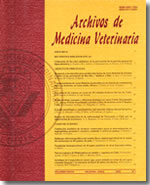Survey for antibodies to pestivirus and herpesvirus in sheep, goats, alpacas (Lama pacos), llamas (Lama glama) guanacos (Lama guanicoe) and vicuña (Vicugna vicugna) from Chile
Main Article Content
Abstract
Microtitration serum virus-neutralization tests were used to determine antibody titres for pestivirus: bovine viral diarrhea virus (NADL strain) and herpesvirus: bovine herpes virus 1 (Los Angeles strain) in 321 sheep, 322 goats, 74 alpacas (Lama pacos ), 43 llamas (Lama glama ), 48 guanacos (Lama guanicoe ) and 34 vicuñas (Vicugna vicugna ), from several Regions of Chile.
Antibodies to pestivirus were found in 60 (18,7%) sheep, in 21 (6,5%) goats, in 8 (10,8%) alpacas and in 6 (14%) llamas. The guanacos and vicuñas did not have antibodies to pestivirus. Antibodies to herpesvirus were found in 8 (2,5%) sheep and in 62 (19,3%) goats. The alpacas, llamas, guanacos and vicuñas did not antibodies to herpesvirus.
From the seropositive animals to pestivirus, the sheep flocks were located in the Metropolitan Region and XII Region of Chile with 7,1% to 82,1% positive serum samples, with titres between 11 to 1024, and 5 (22,7%) positive flocks; The goat flocks were located in the IV Region and the Metropolitan Region with 6,7% to 100% positive serum samples, with titers between 4 to 512, and 3 (13,6%) positive flocks. The alpacas and llamas flocks were located in the Metropolitan Region (where they live with other ruminants). Alpacas 10,8% serum samples from 2 flocks and 14% serum sample of llamas from 1 flock, were positive, with titers between 32 to 2048.
From the seropositive animals to herpesvirus, only one sheep flock was positive and it was located in VI Region of Chile with 28,6% positive serum samples, with titers between 2 to 5,6; The goat flocks positive to herpesvirus were located in the IV Region and the Metropolitan Region with 4,2% to 66,7% positive serum samples, with titers between 2 to 45, and 14 (63,6%) positive flocks.
The serum samples from guanacos and vicunas were obtained from their natural Regions, guanacos from the IV and XII Regions and vicuñas from the I Region.
The findings of our study confirm that pestivirus infections of sheep, goats, alpacas and llamas and herpesvirus infections of sheep and goats occur in Chile.

